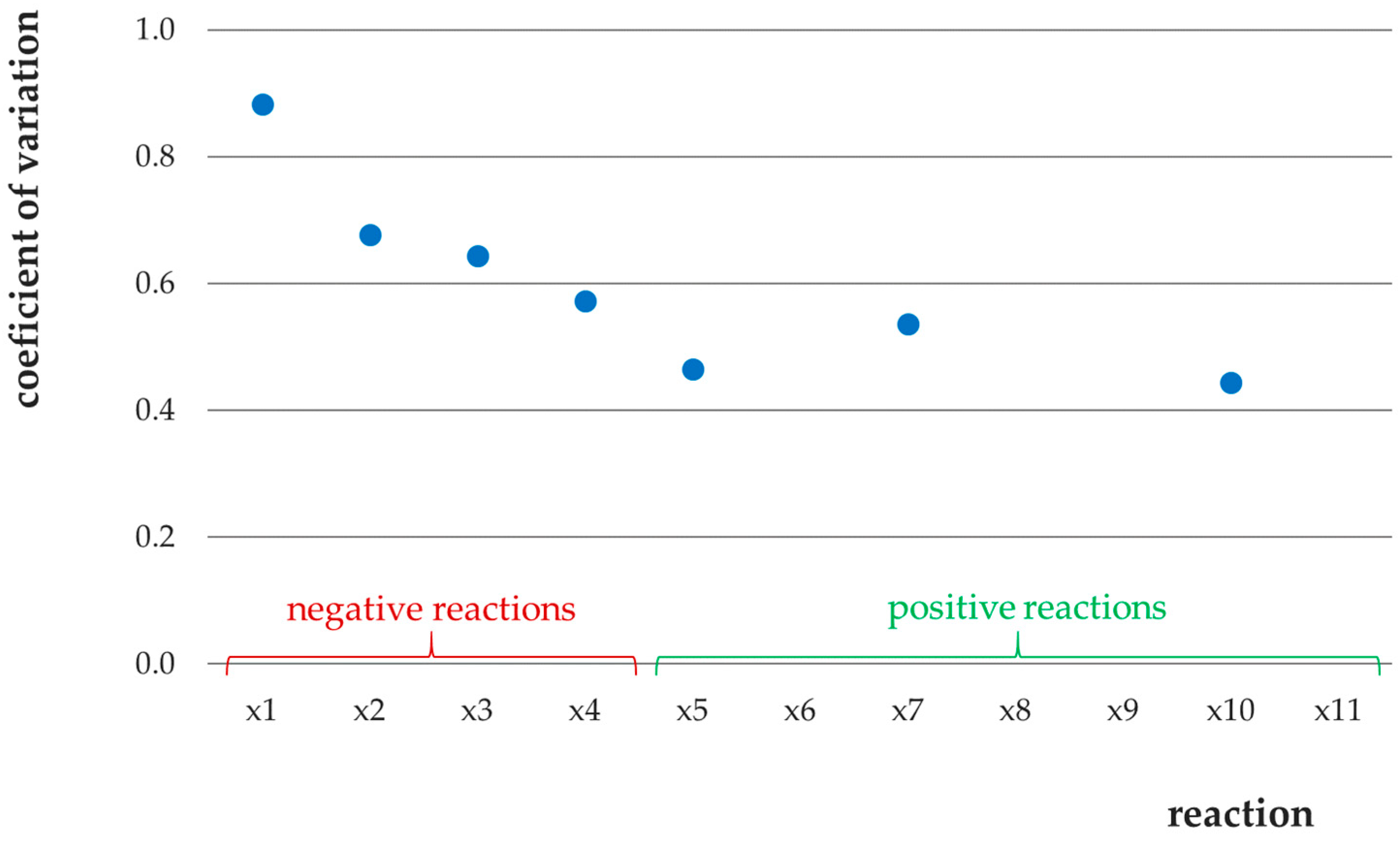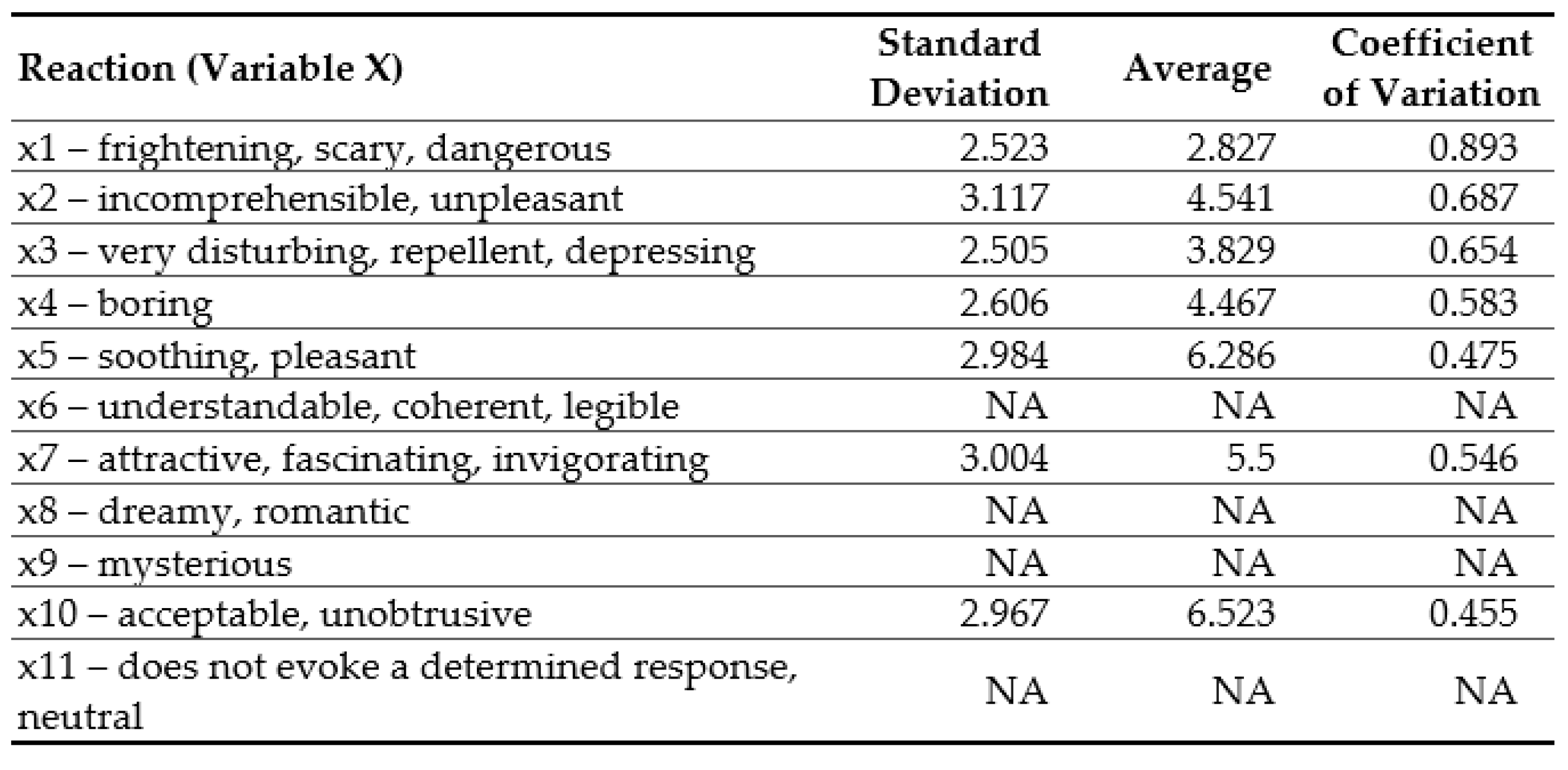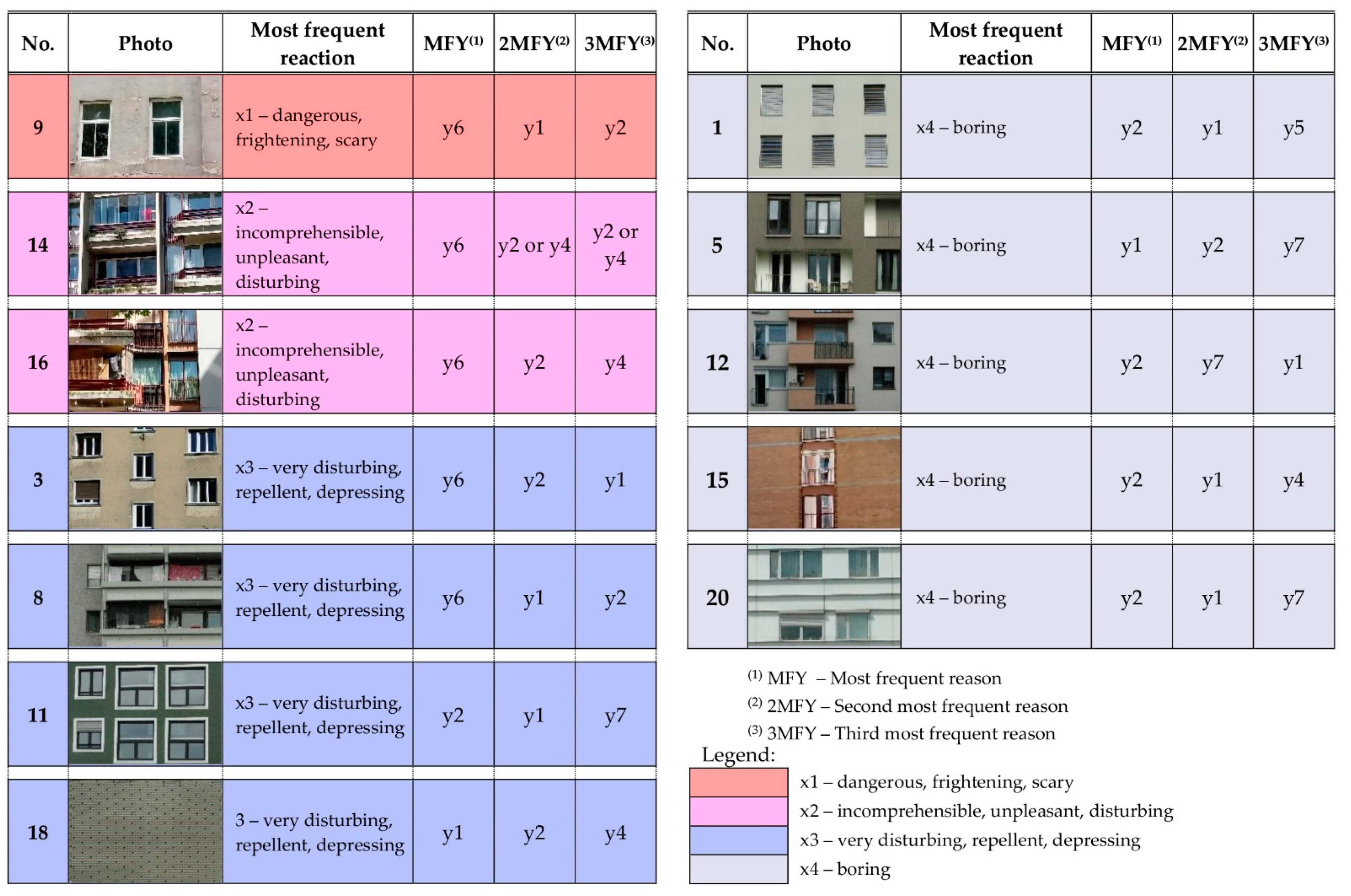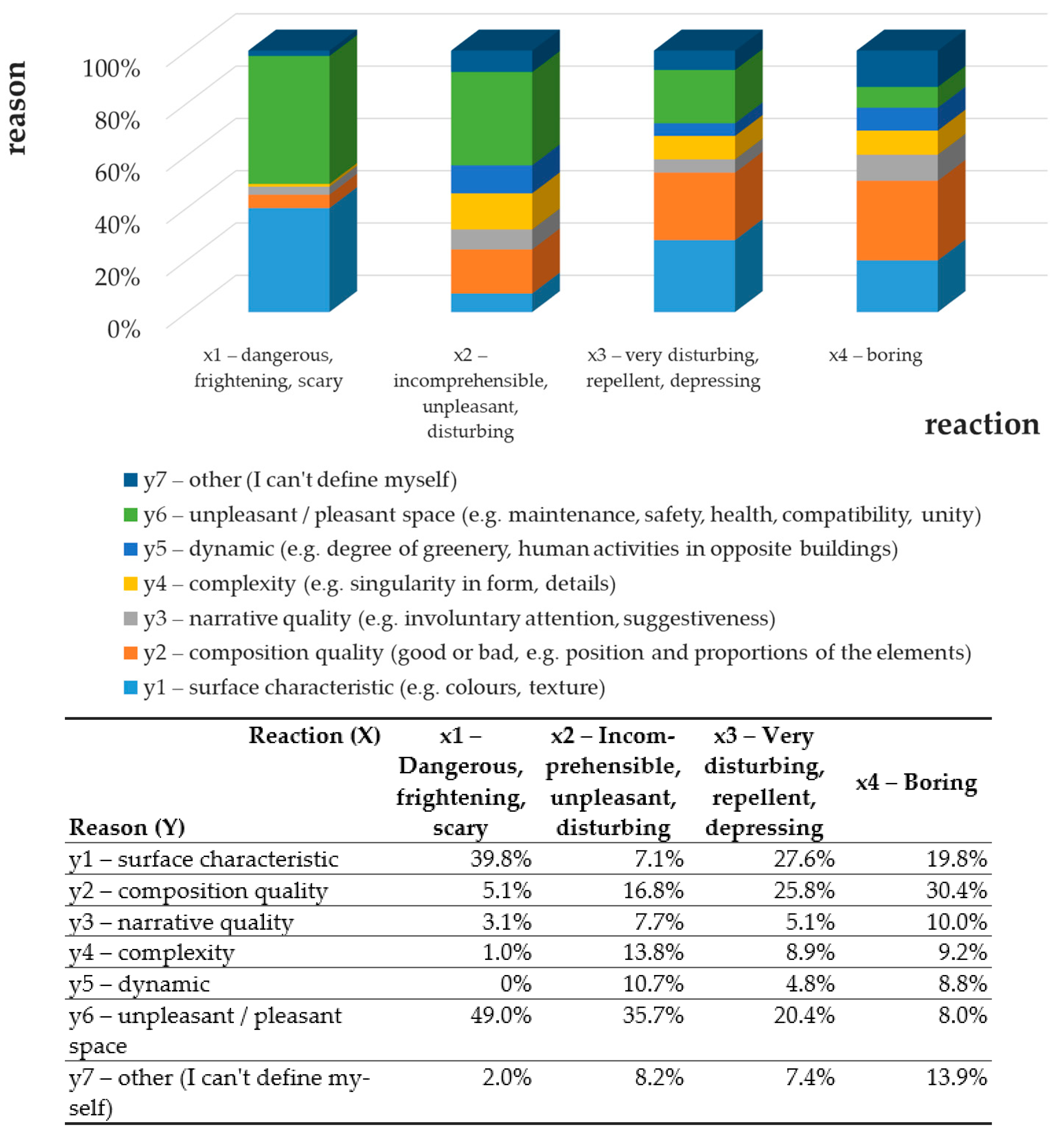Analysis of the Window Views of the Nearby Façades
Abstract
:1. Introduction
1.1. Reaction to Window View
1.2. Urban Density
1.3. Providing Information
1.4. Research Questions
Research Hypothesis
2. Methods
2.1. Preliminary Research
- Geomorphological and real-estate data from the Surveying and Mapping Authority of the Republic of Slovenia [39]. Analyses of geomorphological features (topography, reliefs, terrain types and climate conditions, insolation, distances between buildings, etc.), real estate valuation (real estate register, valuation model register, real estate data from municipalities) and mapping of landscape features with spatial data using ArcGIS software (ArcMap version 10.3.1) for visual assessments and analyses.
- On site observations and analysis. Fieldwork and photographic surveys (April–May 2021).
2.2. Stimuli
2.3. Participants
2.4. Survey and Research Framework
3. Results
3.1. Window View Perception Reactions
3.2. Reasons for the Negative Perception of Window Views
4. Discussion
4.1. Distance of Window View
4.2. Aesthetics of Window View
4.3. Dynamics in the Window View
5. Conclusions
- In the context of urban space, the way of interpreting the results according to “problems mapped by spatial scale” is summarized in terms of “spatial scale: built form” and “sustainable goals: human needs”. Urban densification naturally follows the principles of the concepts of compact cities, in which density is one of the most important planning issues that can regularly lead to all kinds of misunderstandings and tensions, but is an essential driver for our urban future. The study has undoubtedly found that urban densification leads to an impoverishment of window views, but it is not the only determining factor. In this context, urban density does not mean the number of people inhabiting a given urbanized area, but urban intensification in the sense of denser development with less open space. Yet the balance between of built and open space should better follow the principles of sustainable development in the sense of “high density without intensity”. Above all, we need to make a clear distinction between desirable compact city living and the other word that urban planners try to avoid: overcrowding [52].
- It has been shown that visual aesthetics are an important dimension of window view. In particular, features such as compositional quality, maintenance and dynamics have been found to be important. The fact is that a large part of the population spends most of its time indoors. This type of work and lifestyle have increased during the COVID-19 epidemic and will remain so afterwards [18]. We can assume that the students surveyed also spend most of their time indoors, working with devices that require them to focus on nearby objects. This involves constant use of visual displays, such as computer screens or mobile phones, which increases the need for a good view out of the window. However, the specific population studied allowed some characteristics of the window view (e.g., compositional quality and color scheme) to be defined more precisely.
- Furthermore, it was found that interventions into façades can increase the dynamics of the window view. In particular, large, uniform green elements had a mitigating effect on the viewer and were found to be more effective than small and varied elements.
Author Contributions
Funding
Institutional Review Board Statement
Informed Consent Statement
Conflicts of Interest
References
- Rodriguez, F.; Garcia-Hansen, V.; Allan, A.; Isoardi, G. Subjective responses toward daylight changes in window views: Assessing dynamic environmental attributes in an immersive experiment. Build. Environ. 2021, 195, 107720. [Google Scholar] [CrossRef]
- Butler, D.L.; Biner, P.M. Effects of setting on window preferences and factors associated with those preferences. Environ. Behav. 1989, 21, 17–31. [Google Scholar] [CrossRef]
- Stone, N.J.; Irvine, J.M. Direct or indirect window access, task type, and performance. J. Environ. Psychol. 1994, 14, 57–63. [Google Scholar] [CrossRef]
- Kim, U.; Wineman, J. Are Windows and Views Really Better? A Quantitative Analysis of the Economic and Psychological Value of Windows; Working Paper; Taubman College of Architecture and Urban Planning, University of Michigan: Ann Abor, MI, USA, 2005; Available online: http://www.lrc.rpi.edu/programs/daylighting/pdf/viewreport1.pdf (accessed on 26 October 2021).
- Kaplan, R.; Kaplan, S. The Experience of Nature: A Psychological Perspective; Cambridge University Press: Cambridge, UK, 1989; Available online: https://archive.org/details/experienceofnatu00kapl (accessed on 24 October 2021).
- Ulrich, R.S. View through a window may influence recovery from surgery. Science 1984, 224, 420–421. [Google Scholar] [CrossRef] [PubMed] [Green Version]
- Chang, C.C.; Oh, R.R.Y.; Nghiem, L.T.P.; Zhang, Y.; Tan, C.L.Y.; Lin, B.B.; Gaston, K.J.; Fuller, R.A.; Carrasco, L. Life satisfaction linked to the diversity of nature experiences and nature views from the window. Landsc. Urban Plan. 2020, 202, 103874. [Google Scholar] [CrossRef]
- Kent, M.; Schiavon, S. Evaluation of the effect of landscape distance seen in window views on visual satisfaction. Build. Environ. 2020, 183, 107160. [Google Scholar] [CrossRef]
- Yeom, S.; Kim, H.; Hong, T.; Park, H.S.; Lee, D.-E. An integrated psychological score for occupants based on their perception and emotional response according to the windows’ outdoor view size. Build. Environ 2020, 180, 107019. [Google Scholar] [CrossRef]
- Kang, Y.; Kim, E.J. Differences of Restorative Effects While Viewing Urban Landscapes and Green Landscapes. Sustainability 2019, 11, 2129. [Google Scholar] [CrossRef] [Green Version]
- Kley, S.; Dovbishchuk, T. How a Lack of Green in the Residential Environment Lowers the Life Satisfaction of City Dwellers and Increases Their Willingness to Relocate. Sustainability 2021, 13, 3984. [Google Scholar] [CrossRef]
- Elsadek, M.; Liu, B.; Lian, Z. Green façades: Their contribution to stress recovery and well-being in high-density cities. Urban For. Urban Green. 2019, 46, 126446. [Google Scholar] [CrossRef]
- Ko, W.H.; Brager, G.; Schiavon, S.; Zhang, H.; Graham, L.T.; Brager, G.; Mauss, I.; Lin, Y.W. The impact of a view from a window on thermal comfort, emotion, and cognitive performance. Build. Environ. 2020, 175, 106779. [Google Scholar] [CrossRef] [Green Version]
- Kaplan, R. The Nature of the View from Home: Psychological Benefits. Environ. Behav. 2001, 33, 507–542. [Google Scholar] [CrossRef]
- Kaplan, R. The role of nature in the context of the workplace. Landsc. Urban Plan. 1993, 26, 193–201. [Google Scholar] [CrossRef] [Green Version]
- Ozdemir, A. The Effect of Window Views’ Openness and Naturalness on the Perception of Rooms’ Spaciousness and Brightness: A Visual Preference Study. Sci. Res. Essays 2010, 5, 2275–2287. Available online: https://www.semanticscholar.org/paper/The-effect-of-window-views-openness-and-naturalness-Ozdemir/c6e733b2b98173603f016fe47e2f9e128b493425 (accessed on 10 November 2021).
- Van Esch, E.; Minjock, R.; Colarelli, S.M.; Hirsch, S. Office window views: View features trump nature in predicting employee well-being. J. Environ. Psychol. 2019, 64, 56–64. [Google Scholar] [CrossRef]
- Spano, G.; D’Este, M.; Giannico, V.; Elia, M.; Cassibba, R.; Lafortezza, R.; Sanesi, G. Association between indoor-outdoor green features and psychological health during the COVID-19 lockdown in Italy: A cross-sectional nationwide study. Urban For. Urban Green. 2021, 62, 127156. [Google Scholar] [CrossRef] [PubMed]
- Ulrich, R.S. Visual landscapes and psychological wellbeing. Landsc. Res. 1979, 4, 17–23. [Google Scholar] [CrossRef]
- Laumann, K.; Gärling, T.; Morten Stormark, K. Rating scale measures of restorative components of environments. J. Environ. Psychol. 2001, 21, 31–44. [Google Scholar] [CrossRef] [Green Version]
- Laumann, K.; Gärling, T.; Stormark, K.M. Selective attention and heart rate responses to natural and urban environments. J. Environ. Psychol. 2003, 23, 125–134. [Google Scholar] [CrossRef]
- Tennessen, C.M.; Cimprich, B. Views to nature: Effects on attention. J. Environ. Psychol. 1995, 15, 77–85. [Google Scholar] [CrossRef]
- Skärbäck, E.; Björk, J.; Stoltz, J.; Rydell-Andersson, K.; Grahn, P. Green Perception for well-Being in Dense Urban Areas—A Tool for Socioeconomic Integration. Nord. J. Archit. Res. 2014, 2, 179–200. Available online: https://www.researchgate.net/publication/269405003_Green_perception_for_well-being_in_dense_urban_areas_-_a_tool_for_socioeconomic_integration#fullTextFileContent (accessed on 29 October 2021).
- Mladenovič, L. Kriteriji za Trajnostno Načrtovanje in Gradnjo Območij z Visoko Gostoto Poselitve. Ph.D. Thesis, Faculty of Architecture, University of Ljubljana, Ljubljana, Slovenia, 2011. [Google Scholar]
- Čok, G. Residential Buildings and Sustainable Development in Slovenia. Prostor 2014, 22, 134–147. Available online: http://hrcak.srce.hr/index.php?show=clanak&id_clanak_jezik=183572 (accessed on 8 November 2021).
- Gehl, J.; Kaefer, L.J.; Reigstad, S. Close encounters with buildings. Urban Des. Int. 2006, 11, 29–47. [Google Scholar] [CrossRef]
- Fouchier, V.; Merlin, P. (Eds.) High Urban Densities: A Solution for Our Cities; Consulate General of France in Hong Kong: Hong Kong, 1994. [Google Scholar]
- Dimitrovska Andrews, K. Orodja za Usmerjanje in Nadzor Urbanih Oblik; Urbanistični Inštitut Republike Slovenije: Ljubljana, Slovenia, 2011. [Google Scholar]
- Jeon, S.M.; Kang, M.; Kim, S.J.; Kim, Y.J.; Choi, H.B.; Lee, J. Psychological and Physiological Responses to Different Views through a Window in Apartment Complexes. J. People Plants Environ. 2021, 24, 545–550. [Google Scholar] [CrossRef]
- Grütter, J.K. Basics of Perception in Architecture; Springer: Wiesbaden, Germany, 2015. [Google Scholar]
- Schmid, H.-L.; Säumel, I. Outlook and insights: Perception of residential greenery in multistorey housing estates in Berlin, Germany. Urban For. Urban Green. 2021, 63, 127231. [Google Scholar] [CrossRef]
- Elsadek, M.; Liu, B.; Xie, J. Window view and relaxation: Viewing green space from a high-rise estate improves urban dwellers’ wellbeing. Urban For. Urban Green. 2020, 55, 126846. [Google Scholar] [CrossRef]
- Ching, F.D.K. Architecture: Form, Space, & Order, 4th ed.; John Wiley & Sons: Hoboken, NJ, USA, 2015. [Google Scholar]
- Littlefair, P.J. Designing with Innovative Daylighting; IHS BRE Press: Watford, UK, 1996. [Google Scholar]
- Bell, J.; Burt, W. Designing Buildings for Daylight; Construction Research Communications Ltd.: London, UK, 1995. [Google Scholar]
- Masoudinejad, S.; Hartig, T. Window View to the Sky as a Restorative Resource for Residents in Densely Populated Cities. Environ. Behav. 2020, 52, 401–4361. [Google Scholar] [CrossRef]
- Ko, W.H.; Kent, M.G.; Schiavon, S.; Levitt, B.; Betti, G. A window view quality assessment framework. LEUKOS, 2021; in press. [Google Scholar] [CrossRef]
- Szybinska Matusiak, B.; Klöckner, C.A. How we evaluate the view out through the window. Archit. Sci. Rev. 2016, 59, 203–211. [Google Scholar] [CrossRef]
- Ministry of Environment and Spatial Planning, Surveying and Mapping Authority of the Republic of Slovenia. E-Suraying Data. Available online: https://www.gov.si/en/state-authorities/bodies-within-ministries/surveying-and-mapping-authority/ (accessed on 25 April 2020).
- Hall, E.T. The Hidden Dimension; Doubleday: New York, NY, USA, 1966. [Google Scholar]
- Carmona, M.; Tiesdell, S.; Heath, T.; Oc, T. Urban Spaces-Public Places: The Dimensions of Urban Design; Architectural Press: Oxford, UK, 2003. [Google Scholar]
- SIST EN 17037: 2019. Daylight of Buildings. Available online: https://standards.iteh.ai/catalog/standards/sist/6fd9e65f-c3ba-4cda-a69c-dcbd8b7dce8d/sist-en-17037-2019 (accessed on 10 October 2021).
- Brown, D.K.; Barton, J.L.; Gladwell, V.F. Viewing Nature Scenes Positively Affects Recovery of Autonomic Function Following Acute-Mental Stress. Environ. Sci. Technol. 2013, 47, 5562–5569. [Google Scholar] [CrossRef] [Green Version]
- Aries, M.B.C.; Veitch, J.A.; Newsham, G.R. Windows, view, and office characteristics predict physical and psychological discomfort. J. Environ. Psychol. 2010, 30, 533–541. [Google Scholar] [CrossRef]
- Portello, J.K.; Leon, A. Computer-related visual symptoms in office workers. Ophthalmic Physiol. Optic. 2012, 32, 375–382. [Google Scholar] [CrossRef] [PubMed]
- Long, J.; Cheung, R.; Duong, S.; Paynter, R.; Asper, L. Viewing distance and eyestrain symptoms with prolonged viewing of smartphones. Clin. Exp. Optom. 2017, 100, 133–137. [Google Scholar] [CrossRef] [PubMed]
- Thomson, W.D. Eye problems and visual display terminals--the facts and the fallacies. Ophthalmic Physiol. Opt. J. Br. Coll. Ophthalmic Opt. Optom. 1998, 18, 111–119. [Google Scholar] [CrossRef]
- Martens, D.; Gutscher, H.; Bauer, N. Walking in “wild” and “tended” urban forests: The impact on psychological well-being. J. Environ. Psychol. 2011, 31, 36–44. [Google Scholar] [CrossRef]
- Herzog, T.R.; Chernick, K.K. Tranquility and danger in urban and natural settings. J. Environ. Psychol. 2000, 20, 29–39. [Google Scholar] [CrossRef]
- Tenngart Ivarsson, C.; Hagerhall, C. The perceived restorativeness of gardens—Assessing the restorativeness of a mixed built and natural scene type. Urban For. Urban Green. 2008, 7, 107–118. [Google Scholar] [CrossRef] [Green Version]
- Subiza-Pérez, M.; Pasanen, T.; Ratcliffe, E.; Lee, K.; Bornioli, A.; de Bloom, J.; Korpela, K. Exploring psychological restoration in favorite indoor and outdoor urban places using a top-down perspective. J. Environ. Psychol. 2021, 78, 101706. [Google Scholar] [CrossRef]
- Lehmann, S. Sustainable urbanism: Towards a framework for quality and optimal density? Future Cities Environ. 2016, 2, 8. [Google Scholar] [CrossRef]





| Reaction (Variable X) | Reason (Variable Y) |
|---|---|
| x1—frightening, scary, dangerous | y1—surface characteristic |
| x2—incomprehensible, unpleasant | y2—composition quality |
| x3—very disturbing, repellent, depressing | y3—narrative quality |
| x4—boring | y4—complexity |
| x5—soothing, pleasant | y5—dynamics |
| x6—understandable, coherent, legible | y6—unpleasant/pleasant space |
| x7—attractive, fascinating, invigorating | y7—other (can’t define) |
| x8—dreamy, romantic | |
| x9—mysterious | |
| x10—acceptable, unobtrusive | |
| x11—does not evoke a determined response, neutral |
Publisher’s Note: MDPI stays neutral with regard to jurisdictional claims in published maps and institutional affiliations. |
© 2021 by the authors. Licensee MDPI, Basel, Switzerland. This article is an open access article distributed under the terms and conditions of the Creative Commons Attribution (CC BY) license (https://creativecommons.org/licenses/by/4.0/).
Share and Cite
Drobne, S.; Zbašnik-Senegačnik, M.; Kristl, Ž.; Koprivec, L.; Fikfak, A. Analysis of the Window Views of the Nearby Façades. Sustainability 2022, 14, 269. https://doi.org/10.3390/su14010269
Drobne S, Zbašnik-Senegačnik M, Kristl Ž, Koprivec L, Fikfak A. Analysis of the Window Views of the Nearby Façades. Sustainability. 2022; 14(1):269. https://doi.org/10.3390/su14010269
Chicago/Turabian StyleDrobne, Samo, Martina Zbašnik-Senegačnik, Živa Kristl, Ljudmila Koprivec, and Alenka Fikfak. 2022. "Analysis of the Window Views of the Nearby Façades" Sustainability 14, no. 1: 269. https://doi.org/10.3390/su14010269
APA StyleDrobne, S., Zbašnik-Senegačnik, M., Kristl, Ž., Koprivec, L., & Fikfak, A. (2022). Analysis of the Window Views of the Nearby Façades. Sustainability, 14(1), 269. https://doi.org/10.3390/su14010269







